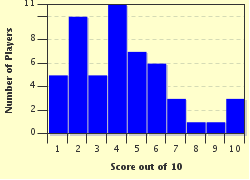Quiz Answer Key and Fun Facts
1. Wehrmacht's Army Group Center had the task of capturing Moscow by early autumn. However, during the summer of 1941, their advance on Moscow was delayed for two months. Which one of these was NOT a reason in the postponement of Army Group Center's offensive on Moscow and leading to diversion of its resources elsewhere?
2. In the first several months of the war, Red Army suffered devastating losses in personnel and materiel. In which sector of the front was the initial German advance slowest?
3. During the summer of 1941, the Wehrmacht achieved many remarkable victories. Which of these four was NOT a reason in the catastrophic early defeats of Red Army in the summer of 1941?
4. The encirclement of Soviet troops and German victory at Kiev in September 1941 cost Red Army approximately 700,000 casualties, including over 450,000 POWs. Was it the only costliest single Red Army defeat during Operation Barbarossa or was there another Red Army defeat that is comparable to the Kiev disaster?
5. After suffering the first major defeat of WW2 during the Battle of Moscow in the winter of 1941-1942, the Germans were able to stabilize the front during the spring of 1942. Which one of these Soviet offensives during the spring and early summer of 1942 achieved success of further weakening the German frontlines?
6. In the summer of 1942 the Germans launched "Fall Blau" (English: Case Blue), a major strategic offensive in Southern Russia and towards Caucasus oil fields. Due to the losses sustained in 1941-1942, the Wehrmacht began to experience shortages in personnel and as a result it had to rely more on its Axis allies. Which Axis country contributed the most troops in the summer advances of 1942?
7. When the Wehrmacht launched Fall Blau on June 28th 1942, it initially had great successes with Germans achieving tremendous territorial gains in Southern Russia. Which one of these was a reason that lead to the early successes of German advance during Fall Blau?
8. In the midst of German advance during Fall Blau, on 13th of July Hitler decided to split Army Group South into 2 parts- Army Group A which was supposed to advance to the Caucasus, and Army Group B which was supposed to advance on Stalingrad. Which one of these was NOT a reason that lead to Hitler splitting Army Group South into 2?
9. The battle in Stalingrad saw the most brutal fighting the history has ever seen. Once the German infantry reached the city, it gradually began to clear the Soviet defenders from it. Despite all the efforts to completely repulse the Soviets from the city, the Germans ultimately failed as the Soviets resisted tenaciously. What percentage of Stalingrad did the Germans managed to control at the peak of their advance inside the city?
10. From June 1941 to November 1942, when Nazi Germany held the strategic initiative, Red Army suffered catastrophic defeats. Proportionally the Germans too, suffered high losses that were incomparably higher than those sustained in Poland, France and North Africa combined. Although Red Army was badly damaged, it was never decisively defeated like the Germans have hoped. What were the approximate casualties (killed, missing, captured, wounded) suffered by the Soviets and the Germans (excluding its Axis allies) from June 1941 to November 1942?
Source: Author
Uspech3da
This quiz was reviewed by FunTrivia editor
bloomsby before going online.
Any errors found in FunTrivia content are routinely corrected through our feedback system.

